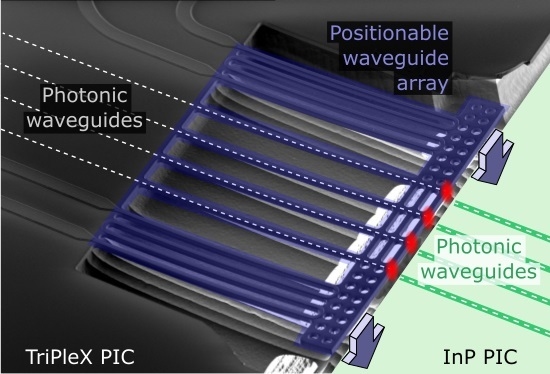Electrothermal Actuators for SiO2 Photonic MEMS
Abstract
:1. Introduction
2. Design
2.1. Out-of-Plane Actuators
2.2. Dimensions
3. Microfabrication
4. Experimental Results
4.1. Actuator Operating Range
4.2. Post-Release Deformation
4.3. Actuation: Bimorph Actuators
4.4. Frequency Response
4.5. Bending Stiffness and Actuator Force
4.6. Transient Response
5. Discussion and Conclusions
Acknowledgments
Author Contributions
Conflicts of Interest
Appendix A. Microfabrication Process
Appendix B. Analytical Multilayer Beam Model
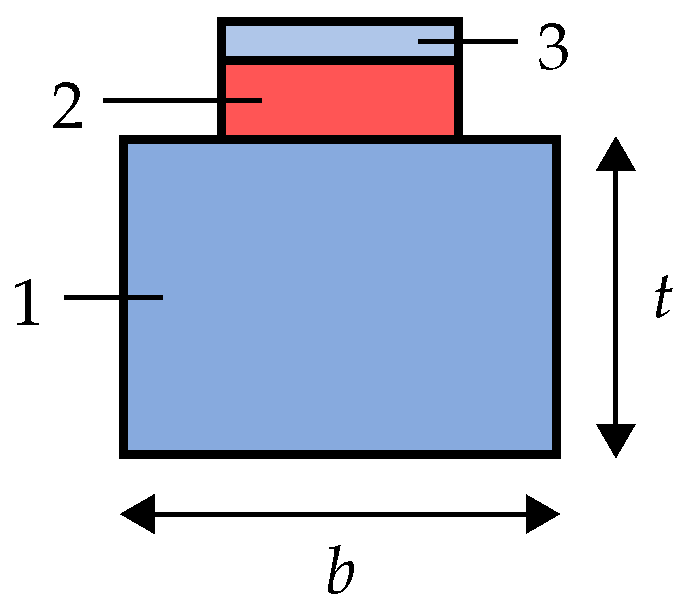
| Layer | 1 | 2 | 3 |
|---|---|---|---|
| Material | TriPleX | Poly-Si | SiO |
| b () | 18 | 12 | 12 |
| t () | 16 | 3 or 5 | 2 |
| E () | 70 | 160 | 75 |
| α () | 0.5 | 3.44 | 2.5 |
Appendix C. Determining the Mass
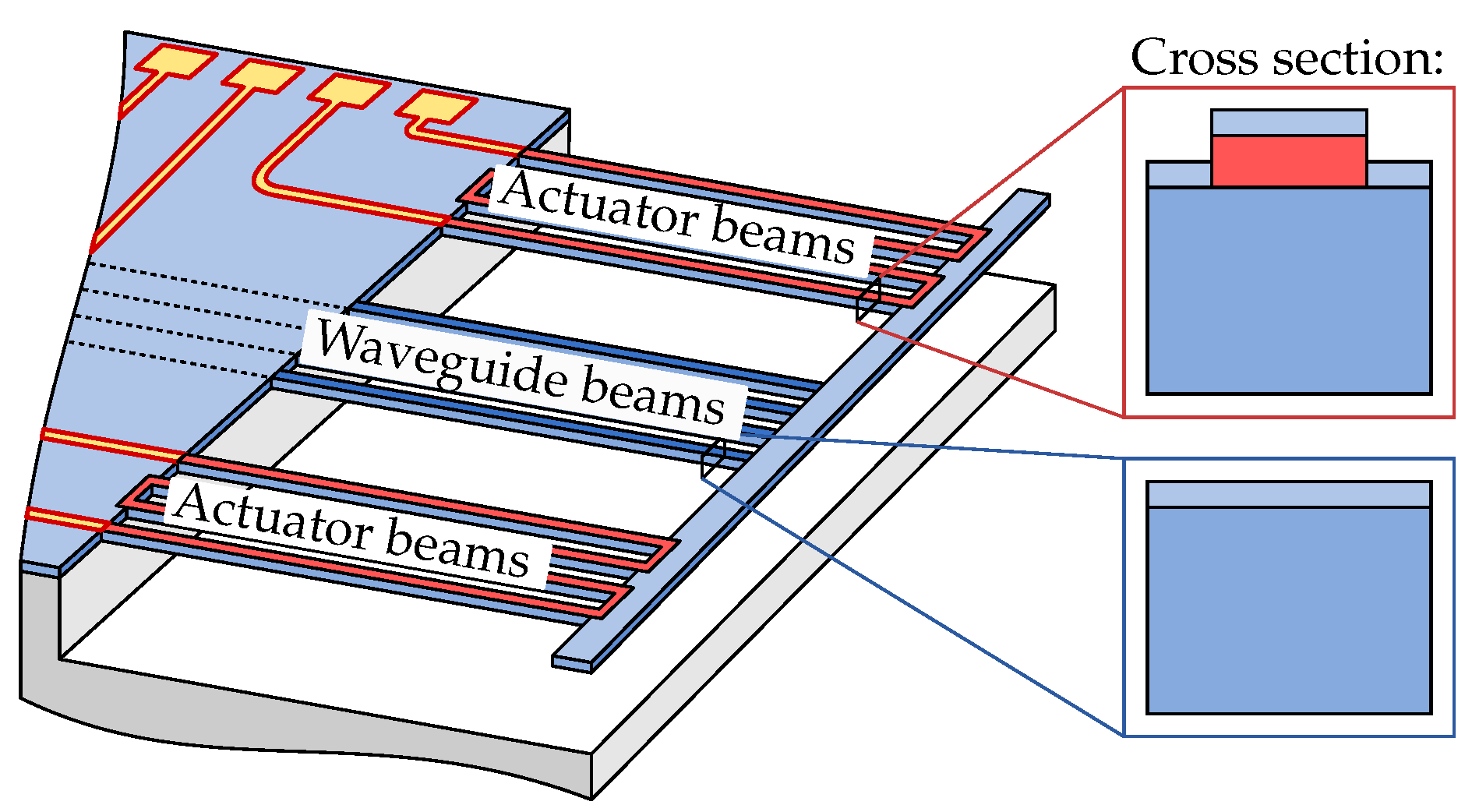
Appendix C.1. Waveguide Beams
Appendix C.2. Actuator Beams
Appendix C.3. Crossbar
References
- Liu, H.B.; Chollet, F. Moving Polymer Waveguides and Latching Actuator for 2 × 2 MEMS Optical Switch. J. Microelectromech. Syst. 2009, 18, 715–724. [Google Scholar]
- Ollier, E. Optical MEMS Devices Based on Moving Waveguides. IEEE J. Sel. Top. Quantum Electron. 2002, 8, 155–162. [Google Scholar] [CrossRef]
- Bakke, T.; Tigges, C.P.; Lean, J.J.; Sullivan, C.T.; Spahn, O.B. Planar Microoptomechanical Waveguide Switches. IEEE J. Sel. Top. Quantum Electron. 2002, 8, 64–72. [Google Scholar] [CrossRef]
- Du, H.; Chau, F.S.; Zhou, G. Mechanically-Tunable Photonic Devices with On-Chip Integrated MEMS/NEMS Actuators. Micromachines 2016, 7, 69. [Google Scholar] [CrossRef]
- Chollet, F. Devices Based on Co-Integrated MEMS Actuators and Optical Waveguide: A Review. Micromachines 2016, 7, 18. [Google Scholar] [CrossRef]
- Stievater, T.H.; Pruessner, M.W.; Rabinovich, W.S.; Park, D.; Mahon, R.; Kozak, D.A.; Boos, J.B.; Holmstrom, S.A.; Khurgin, J.B. Suspended Photonic Waveguide Devices. Appl. Opt. 2015, 54, F164–F173. [Google Scholar] [CrossRef]
- Wörhoff, K.; Heideman, R.G.; Leinse, A.; Hoekman, M. TriPleX: A Versatile Dielectric Photonic Platform. Adv. Opt. Technol. 2015, 4, 189–207. [Google Scholar] [CrossRef]
- Cooper, P.A.; Carpenter, L.G.; Mennea, P.L.; Holmes, C.; Gates, J.C.; Smith, P.G.R. Integrated Optical Dual-cantilever Arrays in Silica on Silicon. Opt. Express 2014, 22, 31801–31813. [Google Scholar] [CrossRef]
- Peters, T.J.; Tichem, M. Fabrication and Characterization of Suspended Beam Structures for SiO2 Photonic MEMS. J. Micromech. Microeng. 2015, 25, 105003. [Google Scholar] [CrossRef]
- Peters, T.J.; Tichem, M. Mechanically Flexible Waveguide Arrays for Optical Chip-to-Chip Coupling. In Proceedings of the SPIE MOEMS and Miniaturized Systems XV, San Francisco, CA, USA, 13 Febuary 2016; Volume 9760, p. 97600D.
- Wu, K.; Peters, T.J.; Tichem, M.; Postma, F.; Prak, A.; Wörhoff, K.; Leinse, A. Bimorph Actuators in Thick SiO2 for Photonic Alignment. In Proceedings of the SPIE Optical Interconnects XVI, San Francisco, CA, USA, 13 February 2016; Volume 9753, p. 975311.
- Chui, B.W.; Asheghi, M.; Ju, Y.S.; Goodson, K.E.; Kenny, T.W.; Mamin, H.J. Intrinsic-carrier Thermal Runaway in Silicon Microcantilevers. Microsc. Thermophys. Eng. 1999, 3, 217–228. [Google Scholar]
- Lee, J.; Beechem, T.; Wright, T.L.; Nelson, B.A.; Graham, S.; King, W.P. Electrical, Thermal, and Mechanical Characterization of Silicon Microcantilever Heaters. J. Microelectromech. Syst. 2006, 15, 1644–1655. [Google Scholar] [CrossRef]
- Henneken, V.A.; Tichem, M.; Sarro, P.M. In-Package MEMS-based Thermal Actuators for Micro-Assembly. J. Micromech. Microeng. 2006, 16, S107. [Google Scholar] [CrossRef]
- Peters, T.J.; Tichem, M.; Wu, K. Modeling the Post-Release Deformation of Multilayer Cantilevers. 2016; submitted. [Google Scholar]
- Peters, T.J.; Tichem, M. On-Chip Positionable Photonic Waveguides for Chip-to-Chip Optical Interconnects. In Proceedings of the SPIE Silicon Photonics and Photonic Integrated Circuits V, 3 April 2016; Volume 9891, p. 98911S.
- Ehmann, M.; Ruther, P.; von Arx, M.; Paul, O. Operation and Short-Term Drift of Polysilicon-heated CMOS Microstructures at Temperatures up to 1200 K. J. Micromech. Microeng. 2001, 11, 397. [Google Scholar] [CrossRef]
- Yi, J.W.; Shih, W.Y.; Shih, W.H. Effect of Length, Width, and Mode on the Mass Detection Sensitivity of Piezoelectric Unimorph Cantilevers. J. Appl. Phys. 2002, 91, 1680–1686. [Google Scholar] [CrossRef]
- Yang, J.; Kahn, H.; He, A.Q.; Phillips, S.M.; Heuer, A.H. A New Technique for Producing Large-Area As-Deposited Zero-Stress LPCVD Polysilicon Films: The MultiPoly Process. J. Microelectromech. Syst. 2000, 9, 485–494. [Google Scholar] [CrossRef]
- Scott, S.; Kim, J.I.; Sadeghi, F.; Peroulis, D. An Analytical Capacitance Model of Temperature-Sensitive, Large-Displacement Multimorph Cantilevers: Numerical and Experimental Validation. J. Microelectromech. Syst. 2012, 21, 161–170. [Google Scholar] [CrossRef]
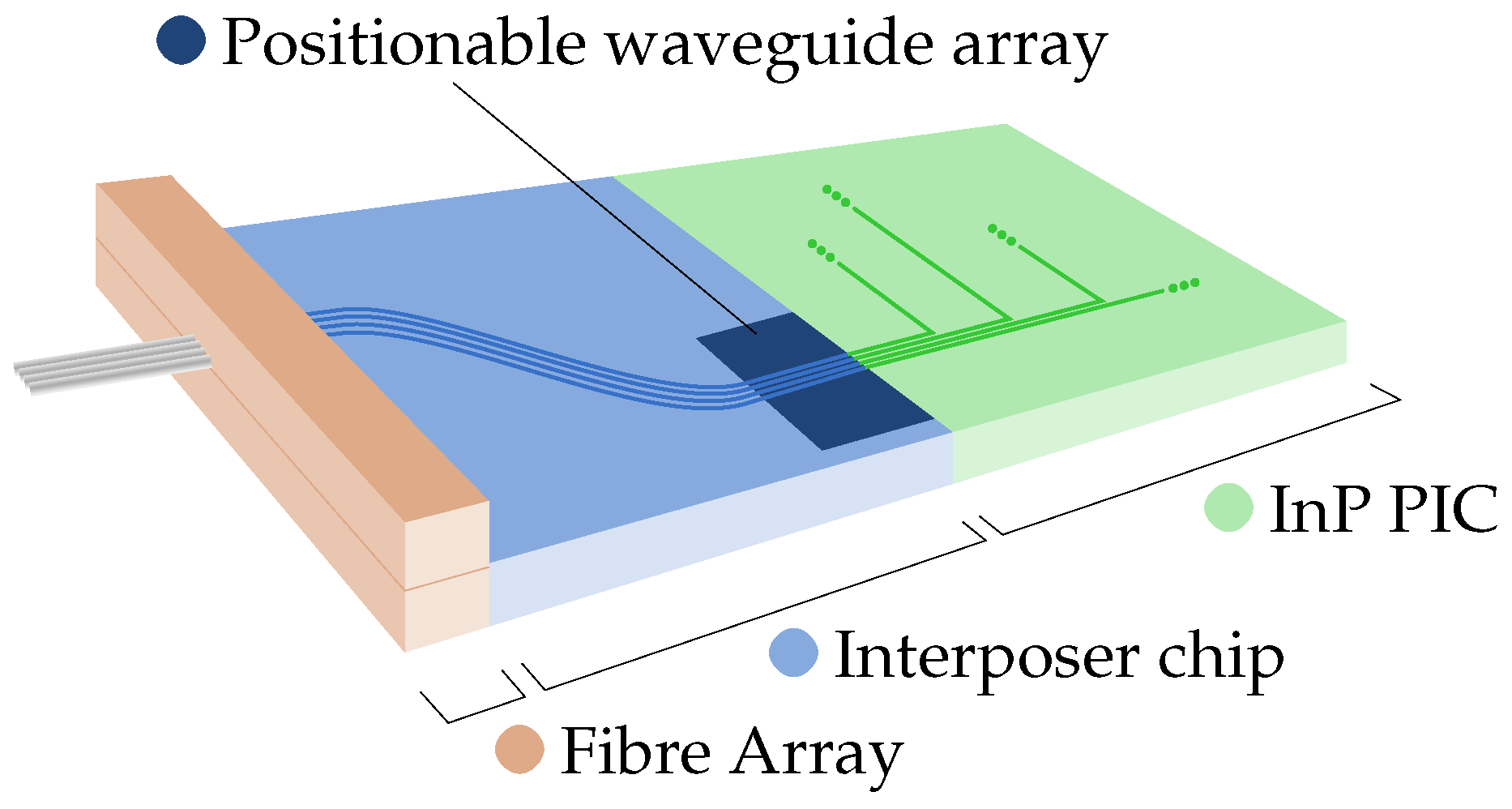
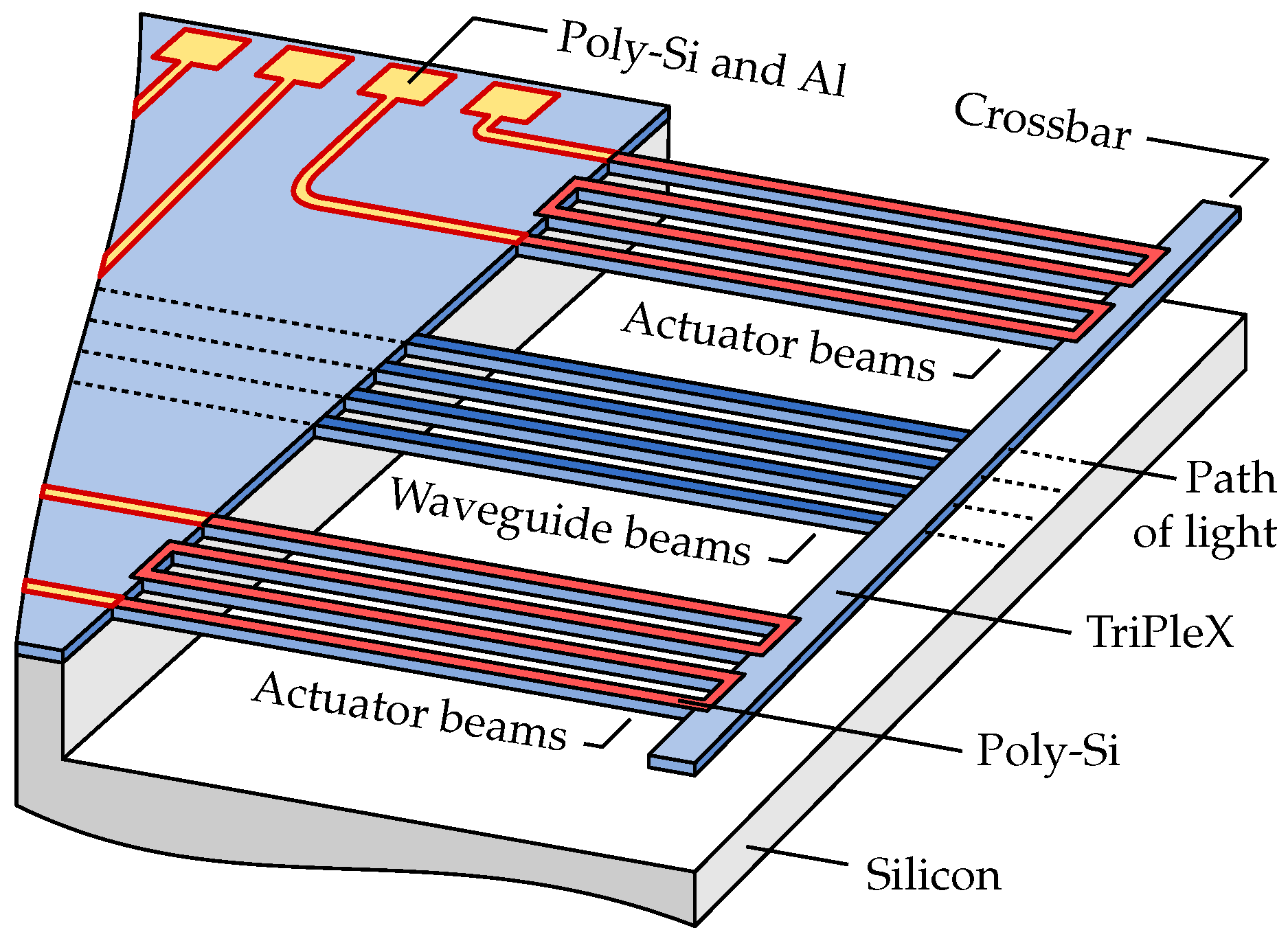


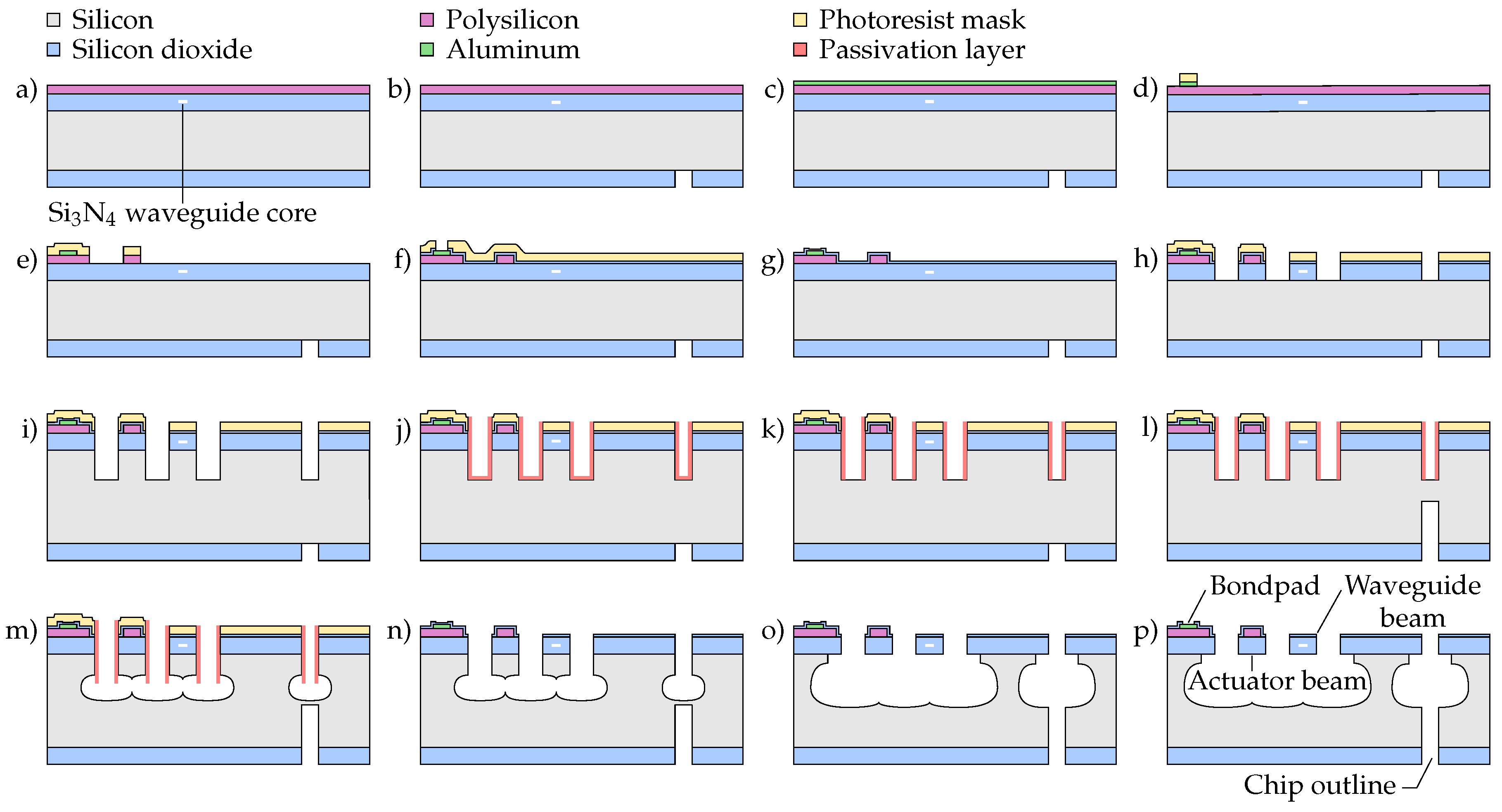
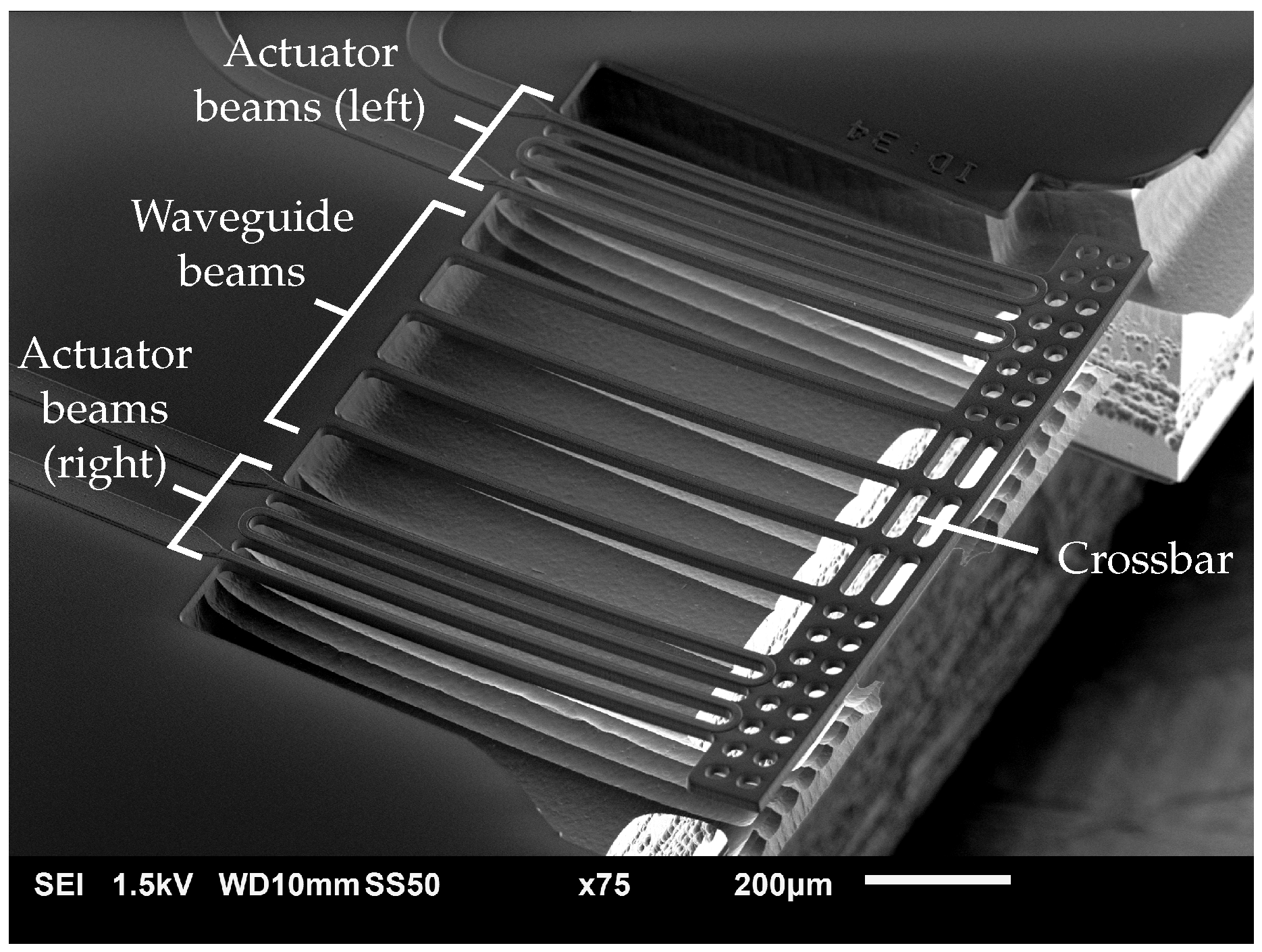

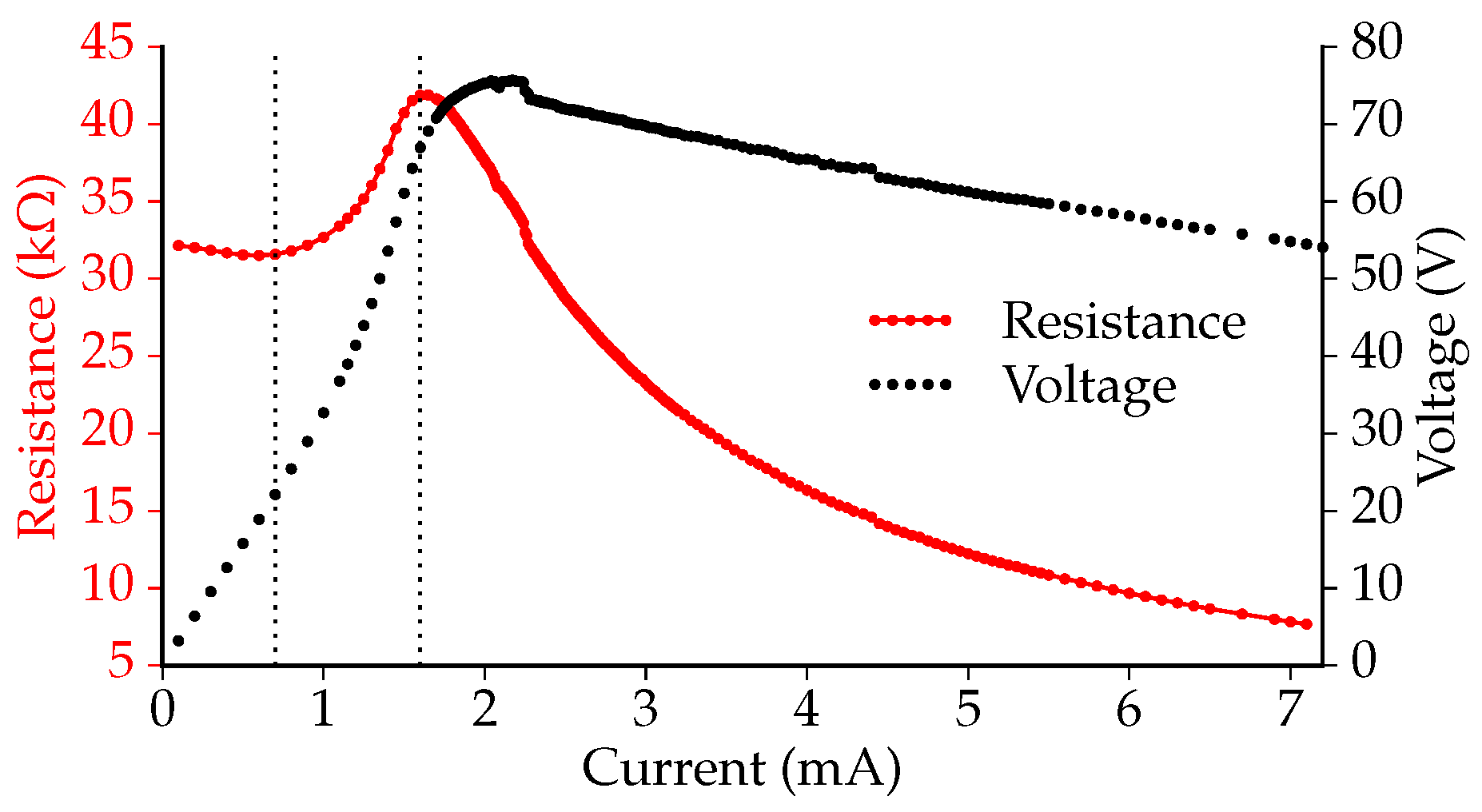
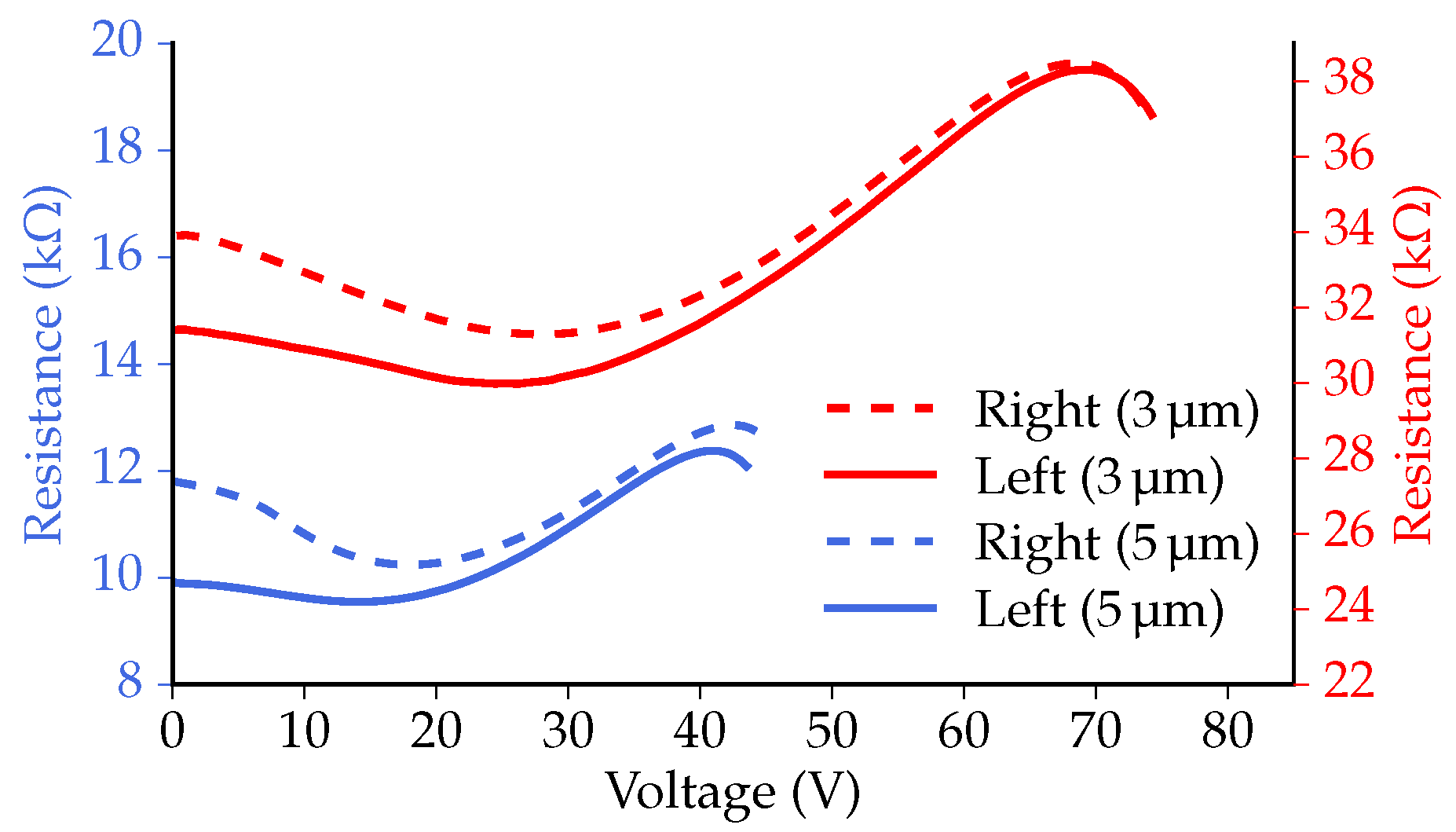



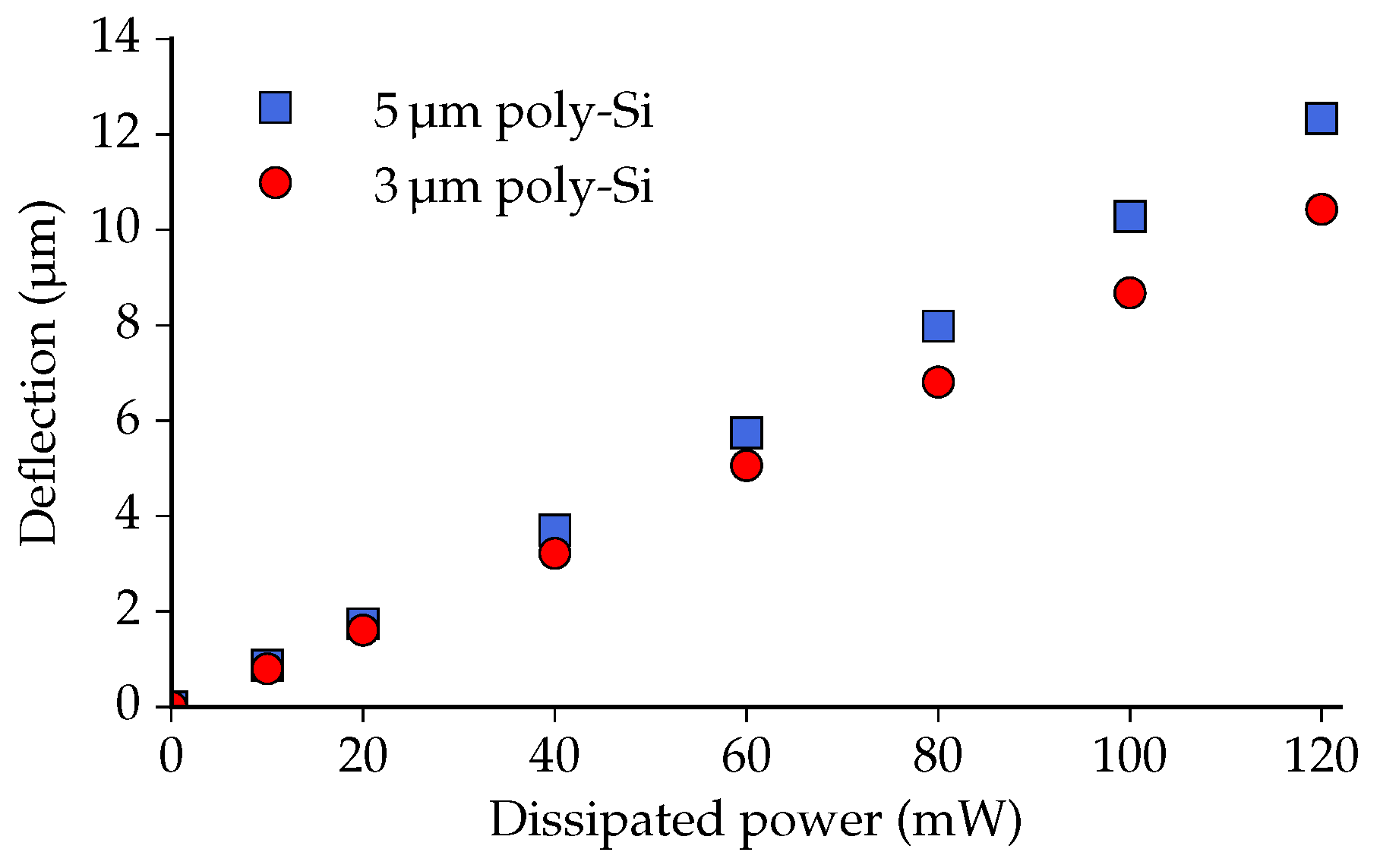
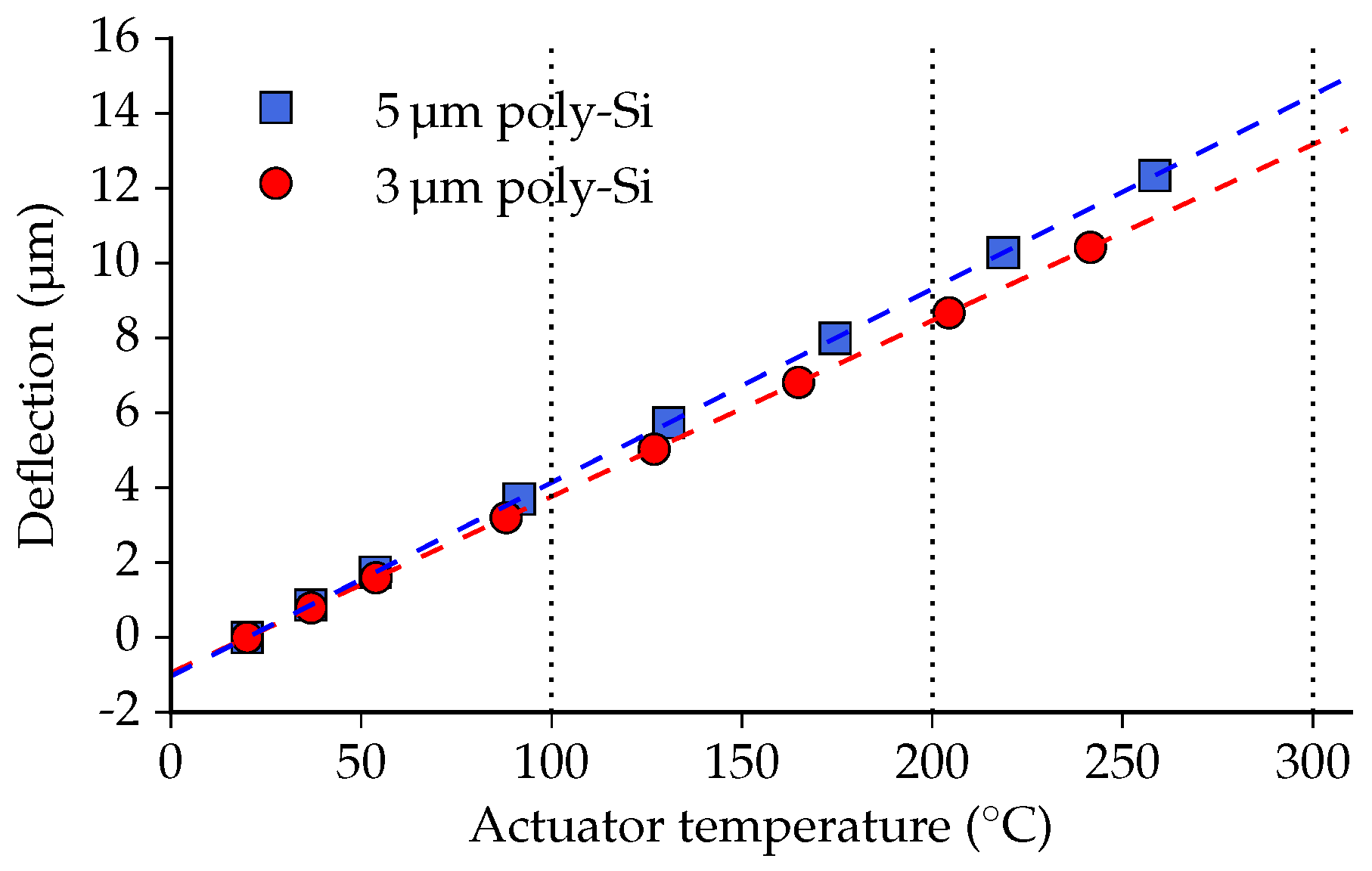

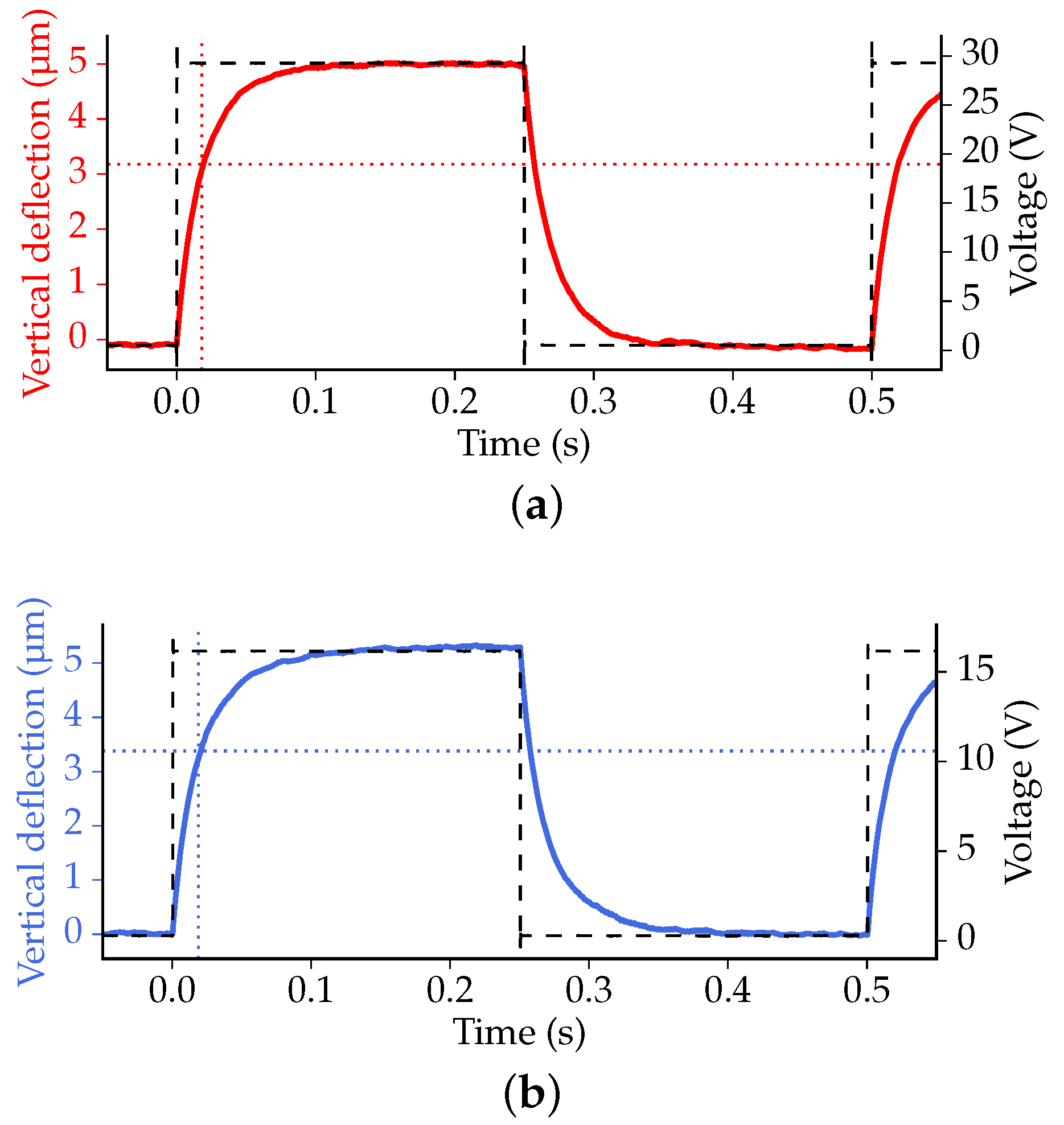
| Parameter | Value | Rationale |
|---|---|---|
| Number of waveguide (WG) beams | 4 | p |
| WG beam thickness () | 16 | p + m |
| WG beam width () | 18 | p + m |
| WG beam length () | 800 | m |
| WG pitch () | 127 | p |
| Number of bimorph beams | 8 | m |
| Bimorph beam pitch () | 50 | m |
| Crossbar width () | 118 | m |
| Poly-Si thickness () | 3 or 5 | m |
| WG core width () | 1 | p |
| WG core thickness () | 200 | p |
© 2016 by the authors. Licensee MDPI, Basel, Switzerland. This article is an open access article distributed under the terms and conditions of the Creative Commons Attribution (CC-BY) license ( http://creativecommons.org/licenses/by/4.0/).
Share and Cite
Peters, T.-J.; Tichem, M. Electrothermal Actuators for SiO2 Photonic MEMS. Micromachines 2016, 7, 200. https://doi.org/10.3390/mi7110200
Peters T-J, Tichem M. Electrothermal Actuators for SiO2 Photonic MEMS. Micromachines. 2016; 7(11):200. https://doi.org/10.3390/mi7110200
Chicago/Turabian StylePeters, Tjitte-Jelte, and Marcel Tichem. 2016. "Electrothermal Actuators for SiO2 Photonic MEMS" Micromachines 7, no. 11: 200. https://doi.org/10.3390/mi7110200





